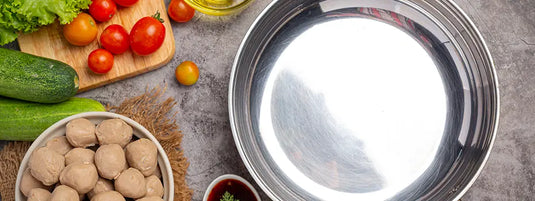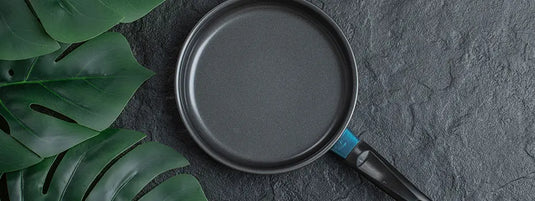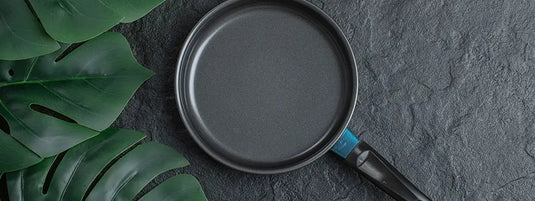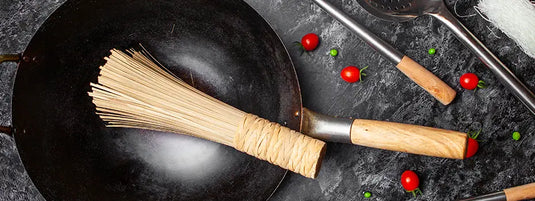Updated: · Kichera Editorial Team · Kichera
Reviewed by: Materials & Culinary Testing at Kichera
Quick Answer
Every cookware & oil has a safety limit. Beyond certain temperatures, coatings can degrade, oils release harmful compounds, and food nutrition drops. In Indian kitchens, we should keep most cooking between 150 °C – 250 °C.
- Stir-fry/tadka: 200–230 °C (oils: groundnut, rice bran)
- Deep fry: 180–200 °C (oils: refined sunflower, mustard)
- Slow cook/braise: 120–160 °C
- Roasting or dry sear: up to 260 °C (max safe for cast iron / triply)
Explore our Cast Iron Collection and Triply Stainless Cookware for high-heat-safe pans.
Why Pan Temperature & Smoke Point Matter
When we overheat oils, their natural fats break down into free radicals and acrolein — a compound that irritates eyes and throat. Overheating cookware (especially coated pans) can damage protective layers or release unwanted fumes.
Goal: stay under the oil’s smoke point and within the pan’s rated temperature.
Common Cooking Oils & Their Smoke Points (°C)
| Oil | Unrefined | Refined | Best Use |
|---|---|---|---|
| Mustard Oil | 190 °C | 220 °C | Tadka & deep frying |
| Coconut Oil | 175 °C | 230 °C | Curries & sauté |
| Groundnut Oil | 160 °C | 230 °C | High-heat frying |
| Sunflower Oil | 180 °C | 225 °C | Shallow fry |
| Ghee (Clarified Butter) | 250 °C | — | Tadka, roast |
| Rice Bran Oil | — | 240 °C | Multi-purpose |
| Olive Oil | 160 °C | 210 °C | Medium-heat sauté |
Safe Temperature Limits by Cookware Type
- Cast Iron / Carbon Steel: Up to 260 °C — preheat gradually; season regularly.
- Triply Stainless Steel: Up to 280 °C — avoid overheating empty pans.
- Solid Ceramic: Up to 230 °C — avoid sudden thermal shock.
- Ceramic-Coated / Non-Stick: Stay below 250 °C — overheating can degrade coating.
See our Solid Ceramic vs Ceramic-Coated Guide for more on coating stability.
Practical Tips to Control Heat & Stay Safe
- Preheat pans for 1–2 minutes max before adding oil or food.
- Use infrared thermometers or visual clues (slight oil shimmer = ~180 °C).
- If oil smokes, remove from heat immediately.
- Never leave empty pans on high flame — especially non-stick or ceramic.
- Match oil type to cooking temperature to retain flavour & nutrition.
Cookware Built for Safe Temperatures
- High-heat tadka & roast: Cast Iron Kadai / Tawa
- Precision cooking: Triply Stainless Saucepan & Fry Pan
- Low-oil gentle cooking: Solid Ceramic Cookware
FAQs
What is the safest temperature for non-stick pans?
Keep non-stick below 250 °C (480 °F). Beyond this, PTFE or ceramic coatings can degrade and release fumes.
Which oil is best for high-heat Indian cooking?
Refined mustard, groundnut, rice bran, and ghee handle high temperatures well without breaking down quickly.
Can we use olive oil for Indian frying?
Use olive oil only for medium-heat sauté (~160–200 °C). It’s not ideal for deep frying or tadka.
How to know if oil is overheated?
If it smokes, smells acrid, or turns dark quickly — it’s past its smoke point. Discard and start fresh.
Explore the full cookware safety series: Cast Iron vs Carbon Steel · 304 vs 316 Triply Stainless · Solid Ceramic vs Coated Safety · How to Season Cast Iron




